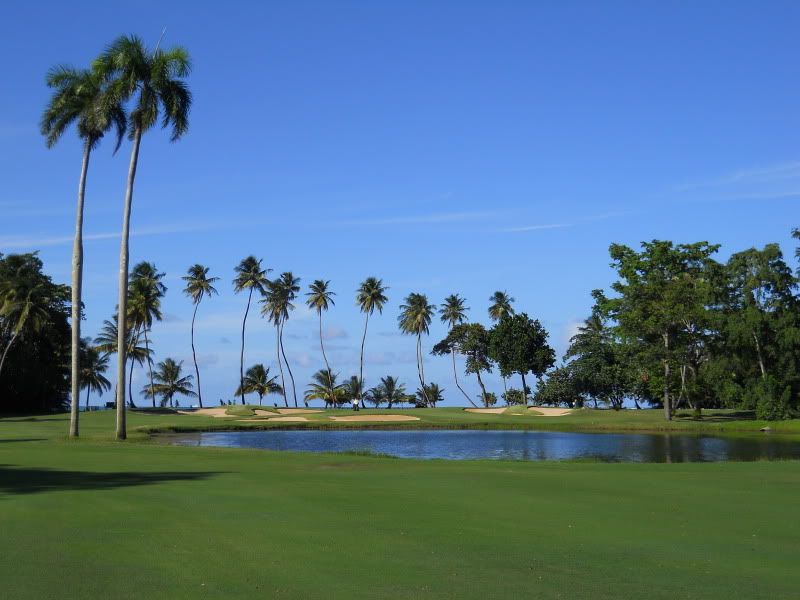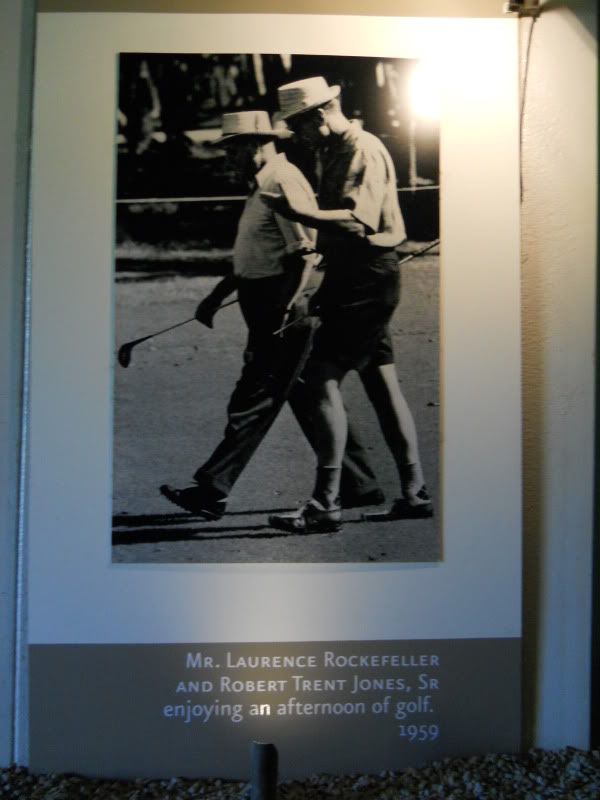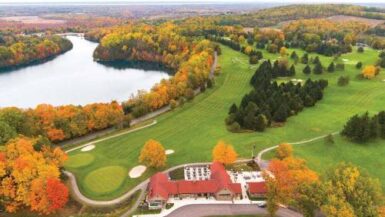
DORADO, Puerto Rico – Part I – The high-flying, death-defying, five-ring circus life of a sports writer
Thursday, 7:36 a.m. Wheels up out of JFK and I’m frightened to the marrow of my bones. The plane has been shaking and wobbling since it taxied out of Gate B22 and it’s only gotten worse after a slow, tortured climb to 33,000 feet.
As you well remember, Dear Reader, I swore to you that after Delta’s lunatic misadventures in getting me from LaGuardia to Atlanta last August (it took those imbeciles 48 hours to get me there – unacceptable) I would never fly that junior varsity airline again. No one loses my golf clubs like Delta, no airline burdens me with more delays or cancellations than Delta, and no flights fill me with greater horror than Delta. Sure enough, when the good folks at Kemper Lesnik (the P.R. firm handling the festivities for the grand reopening of the East Course at the Dorado Beach Resort) sent me my flight itinerary, there it was – Delta – the four-letter word of the airline industry.
It’s my fault; I forgot to tell Simon Landon not to book me on Delta. Had he known, he would have booked me on another carrier, he’s good that way. Few P.R. folks have Simon’s savvy. For a young fellow, he’s sharp, obliging and genuine without being fawning. A good P.R. person is like a good waitress, they are there when you need them, but they let you have your space as well.
I first met Simon at the PGA Championship in Atlanta and, happily, he was a splendid companion to share a desk with in the media tent. When we talked, we found common ground in Bob Jones, Jr., the pre-eminent golf course architect. As you all know, Jones and I have been friends ever since I interviewed him a few years back. We talk architecture together, we wrote poetry together, and we discuss intellectual property in the golf world together. So when Simon mentioned that Bob had just finished doing a restoration of the famous East Course at Dorado Beach and that writers were being invited down to play and review it, I was glad to sign up.
This was an assignment I desperately needed. Out of the valley of shadow – that concrete morgue of a courthouse where my lawyer life tries to suck out every bit of creativity and individuality I have (law is a vicious, soul-ripping business, on the litigation side at least) – away from my insipid landlord who has become the laughing stock of Forest Hills through her inability to prevent one of her business tenants from become the neighborhood’s biggest nuisances, and back to the land of the living after an assignment that would be mellow and restful. Review a golf course and resort in the Caribbean, where palm trees dip and sea gulls swerve, this was what my weary bones and mind needed. No working on three hours sleep, no overnight deadline, no mind-scrambling pressure, just my clubs, laptop, shorts, sunglasses, sun tan lotion, and a fine, wide gringo smile for the customs officers before being whisked off to the practice range. Then back to the beach for a Bacardi while waiting for the other writers to arrive. Who knows? Maybe I’ll even take a dip in the ocean.
As you also know, however, this will most certainly not be some left-handed, high style bag job. You read my column because I have no guile, no fear, and no baggage. I am beholden to no one, so I can tell you the truth of what I see.
“That’s what makes you perfect for this job, Jay,” said Bob Jones in my pre-trip interview with him. “You’ll give it to me straight. I really want to know what you think of the course itself and of the work we did there.”
So that’s exactly what I’ll do. I’ll break down the golf course like a fraction for you, but I’ll also give you the honest evaluation of what it’s like to take a vacation there – Dorado Beach, Puerto Rico. We’ll discuss “Why Puerto Rico?” and “Why Dorado Beach?” We’ll meet Bruce Charlton, Bob’s second-in-command at RTJ II golf designs, and we’ll renew acquaintances with my good right hand man on gigs like this, Tony Korologos, the Media Guru and the man who gave the world the Golf Space, the best grass roots web-site in golf.
So abroche su cinturon (fasten your seat belts) for a cracking good time…that is if I arrive in one piece, because here I am, knees crushed with by the [expletive deleted] lugnut in front of me who thinks his seat is a reclining rocking chair, no leg room, no pull-out tray table to work on, and petrified with the way the plane shakes and dips and rolls. The fat, incontinent woman next to me gets up every 15 minutes to go to the bathroom, and when she’s sitting down she smells like armpits. And I have little hope that if I survive to publish this piece my golf clubs will arrive in Puerto Rico in time for my departure four days from now. Delta may be the Greek letter “D,” but from me they get a flat-out “F” every time.
“That’s nothing,” said one Delta rep who rode the shuttle with me. “You should see the morning Tokyo flight. That flight is doomed.”
Those were her exact words. I asked why.
“It’s an old plane that always has problems and it’s constantly delayed or canceled.” How wonderful. What a way to run a carrier business.
Then when I told her about her employer’s perfect 4-for-4 record in losing my golf clubs she responded, “We’ve always been good at that.”
Miraculously, despite Delta’s best efforts, my golf clubs arrived safe and sound, which is almost more than I can say for myself…
“Senor! Senor!” shouted the driver who picked me up at the airport, “We saw your plane, and it was wobbling really badly on the landing!”
Try being in it! I felt like I was the little ball in the can of spray paint and someone was trying to give it a good shake. Yet after a few signs of the cross, shared looks of horror with the other passengers, and tepid apologies from the flight crew, I have arrived at Dorado (pronounced “Doe-RAH-doe” like staccato, not “Doe-RAY-doe” like Laredo), and all the consternation turns out to be worth it, for as far as the eye can see it’s coral skies, golden sand, sapphire seas, and emerald fairways for the Grand Reopening of the famous East Course.
“Welcome to Paradise” the sign reads, and thankfully, I’m in no mood to argue.
Part II – Keeping up with the Joneses
 Like his father, Bob Jones produces golf courses like Puerto Rico produces shortstops – you get plenty of them and they’re all high quality. Dorado Beach, in particular, is an important course in the Jones family legacy. In 1956 Laurence Rockefeller commissioned Robert Trent Jones, Sr., (Trent to his friends), to build the first 18 hole course on the property. Several holes in that first 18-hole design are still part of what is now the East Course. The club added a second 18 holes in 1962-3. There are now a total of 72 holes on the property, as well as a large practice park with chipping areas, putting greens and a Tour quality driving range.
Like his father, Bob Jones produces golf courses like Puerto Rico produces shortstops – you get plenty of them and they’re all high quality. Dorado Beach, in particular, is an important course in the Jones family legacy. In 1956 Laurence Rockefeller commissioned Robert Trent Jones, Sr., (Trent to his friends), to build the first 18 hole course on the property. Several holes in that first 18-hole design are still part of what is now the East Course. The club added a second 18 holes in 1962-3. There are now a total of 72 holes on the property, as well as a large practice park with chipping areas, putting greens and a Tour quality driving range.
Jones’s work here was important for another reason – this was the first major golf resort built in the Caribbean, and its wild success was the impetus for many other tropical golf resorts to be planed, including another Jones Sr. masterpiece, Mauna Kea.
“I remember being there with my dad in the ’50s. It was a wonderful place: sunshine, sea breezes, and a great oceanside piece of land on which to build the course,” said Bob Jones, Jr. “It was an important trip for me, because that’s where the love of golf course design first blossomed in me. That’s where I first felt the love for what would become my life’s work.
“The work Bruce Charlton and the team and I did here was part restoration, part renovation, but all reclamation. It was like an archaeology project,” he continued. “We had to dig to find my father’s work.”
According to Jones, when Hyatt ran the property, “they modified the course in several poor ways. Ray Floyd was their player consultant and he made some questionable suggestions typical of touring pros who aren’t trained in golf course architecture or well-versed in the nuances of golf design.”
For example, they changed green sites so that they were much more severely uphill than what Jones, Sr. had designed. Floyd raised greens to make them tougher targets, but in doing so blocked many of the ocean views that gave the course so much of its character. Greens had lost their original shapes and sizes, and the bunkering was not up-to-date with the technological advances in equipment. Happily, the course is built on sandy soil – by far and away the best surface for playing golf – so not only was the task made easier, but the course will play fast and firm and promote the ground game as well as the aerial attack.
“We had to dig down to find the original green on many of the holes,” continued Jones. “We also had 50 years of trees to either prune or remove altogether. We kept the elegant trees that had been there since the beginning, but there were so many more that had sprung up over the years – after all, it’s the tropics. You turn your back and a palm tree grows.”
They removed about 50 trees and pruned a great many more as they had encroached on playing corridors and limited the airspace needed for amateurs to play the game. There are still many more trees that could be removed, for example at the short downhill par-4 15th, which calls for a draw off the tee, but must avoid a small stand of trees that guard the left side. The trees block the sight line of the green from the tee. While some would say that keeping the trees on the left makes the player hit a good shot – a draw that follows the land – keeping the trees eliminates the option for players to take that line, and my own theory of golf course architecture is that there should be many ways to play a hole, not just one. The hole is fine for the pro, who can shape a draw with ease, but is tougher on resort players of indifferent skill who can’t hit that shot shape on command.

Nevertheless, as the order of the day was to preserve and promote the architectural strategies of Jones the father, not Jones the son, Jones explained that, “We did not impose our own style at all.”
Bruce Charlton echoed that sentiment with a heartwarming observation. “We wanted to make this course a museum showcasing the architecture of Mr. Jones [Sr.]”
As such, at Dorado Beach (East), you’ll find all the hallmarks of Trent – long runway tees, greens and fairways “bracketed” by bunkers, (rather than the cross bunkers Bob Jr., Donald Ross, Tillinghast and Devereux Emmet preferred), inland water hazards formed from the tidal water table and natural lagoons. As we explore the course further in tomorrow’s article, you’ll see that they accomplished that goal admirably.
“We also want to restore Dorado Beach to its former place as the best golf resort in the Caribbean,” added Chi Chi Rodriguez, the colorful and universally loved PGA Tour pro who not only hails from Puerto Rico, but has held nearly every position you can think of at Dorado Beach.
“I was the caddiemaster, I was the starter, I shined shoes, I gave lessons, and I’ve lived here all my life. This is my home, but it is also the home of golf in the Caribbean, and we want bring back the great atmosphere the resort had back in its heyday back when Dwight Eisenhower, Gerald Ford, Tennessee Ernie Ford and Ava Gardner played here and when Ed Dudley was our head professional.”
That’s great company – Ed Dudley was also the head professional at Augusta National.
Then Chi Chi became Chi Chi and made the room fall apart in laughter.
“I gave Jerry Ford lessons, but it did no good, he was too uncoordinated. One day he took a huge divot that flew a few yards, then looked around all confused and asked, ‘where’d the ball go?’ I picked up the divot and the ball was underneath!
So as the sun rises just before 7:00 a.m., the course takes on a golden glow like a crown of glory and, eager as gun dogs who heard their owner take down the firing piece from over the fireplace, we line up on the range to get ready to take a few steps back in time to see what golfers have seen for over half a century.
Tomorrow – A look at the course and more stories from Chi Chi and the RTJ2 design team.



